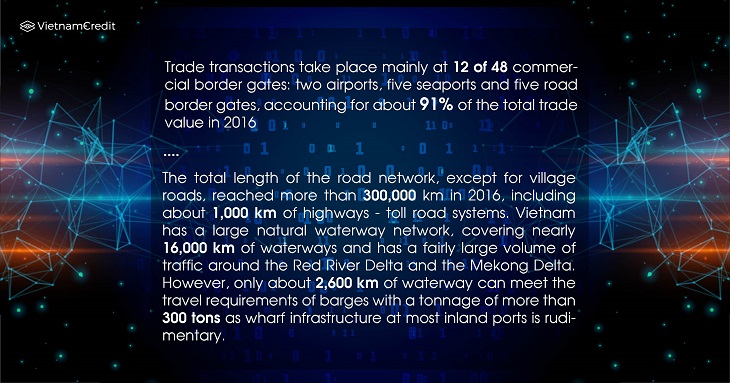The "consumer" class (spending $ 5.50 or more per person per day) is growing rapidly, from about 49% in 2010 to more than 70% in 2016.
Connecting system
Vietnam is currently one of the most open economies in the world with a trade to GDP ratio of 190% in 2018. Through eliminating both tariff and non-tariff barriers and implementing commitments in a number of regional trade agreements, the country has achieved remarkable achievements in trade liberalization. Vietnam connects with most countries in East Asia, North America and Europe mainly via sea or air. Trade with neighboring countries is limited and therefore cross-border trade is minimal except for the northern border with China, where the number of transactions grew greatly during the past few years.
Trade transactions take place mainly at 12 of 48 commercial border gates: two airports, five seaports and five road border gates, accounting for about 91% of the total trade value in 2016. As trade grew, the problem of congestion at and near international border gates and cross-border customs points also began to increase. In addition to current major trading partners, regional trade relations and connectivity initiatives related to Vietnam, including neighboring Southeast Asia, countries participating in the Belt and Road Initiative, South Asia - especially part of Indian territory, have made trade relations grow rapidly.
Meanwhile, Vietnam's transport network has expanded significantly over the past decades, most notably the expansion of the road network. The total length of the road network, except for village roads, reached more than 300,000 km in 2016, including about 1,000 km of highways - toll road systems. Vietnam has a large natural waterway network, covering nearly 16,000 km of waterways and has a fairly large volume of traffic around the Red River Delta and the Mekong Delta. However, only about 2,600 km of waterway can meet the travel requirements of barges with a tonnage of more than 300 tons as wharf infrastructure at most inland ports is rudimentary.

Vietnamese railways have existed for centuries, most of which are single track, do not use electricity, and have remained unchanged for decades with very limited investment. Vietnam has a large seaport system, including 45 ports and nearly 200 berths. The volume of goods transported by sea, including both domestic and short-distance sea freight, has increased continuously. Traffic congestion around the port and along the national highways connected to the port is exacerbating, causing delays in cargo movement and negatively affecting urban movement of big cities. Vietnam's aviation industry has witnessed rapid growth in recent years, air transport grew at an average rate of 10.8% per year between 2009 and 2017. Despite the role of air transport is increasingly important, accounting for about 25% of Vietnam's import-export value, the infrastructure is still limited. Only four of the 22 airports in Vietnam have their own cargo terminals and two have logistic centers.
>> Vietnam aviation industry: foreign ownership to increase
Integration into the global market
Vietnam is an active participant in the global value chain, and benefits from the creation of jobs and mutual understanding when participating in the production of multinational corporations.
International trade of Vietnam is mainly conducted at a few airports, seaports and major border gates. With the rapid increase of aviation, many stakeholders are increasingly concerned with operational capacity and also the physical capacity at important airports. The two dominant ports in Ho Chi Minh City and Hai Phong are operating at nearly full capacity and the roads connecting to this area are really congested. At the same time, new deep-water ports in the Vung Tau and Lach Huyen port clusters provide an opportunity to consolidate cargoes and attract large vessels, thereby reducing transportation costs and time. Investing in inland connections is critical to the success of these ports. Capacity constraints, congestion and the irrationality between supply and demand suggest the need for network thinking in gate planning and development, eliminating the current decentralized planning, whereby local governments compete to own the main border gates.
Economic clusters in Vietnam, mainly under the form of industrial parks or economic zones, are often developed around major corridors, near important international border gates or around large urban areas. The success of these clusters, measured in terms of investment attraction and the number of jobs created, is influenced by connectivity along with other factors. As Vietnam develops a high-speed transport network, such as the North-South Expressway, which narrows the economic gap across the country, new intersections may be potential candidates for future economic clusters.
Integration into the domestic market
The Vietnamese people are getting richer with a more vibrant life. The "consumer" class (spending $ 5.50 or more per person per day) is growing rapidly, from about 49% in 2010 to more than 70% in 2016. About 89% of urban residents belongs to this class, while in rural areas this figure is only about 66%. This emerging group consumes more, and is more diverse in goods and services purchase than the poorer group. Such changes in consumption patterns are the result of a sharp increase in income.
Vietnam is facing complex food issues related to the supply, distribution and quality assurance of fresh food. Although consumer demand for fresh food has increased rapidly, especially in urban areas, the supply and distribution channel has remained little changed: consumers still mainly shop at markets. Traditionally, the food chain is fragmented and food delivery is underdeveloped. The growing demand for fresh food combined with the old methods of moving and distributing foods has led to significant losses, unsafe food, and bad impacts on the environment and public health.
>> Vietnam logistics industry: risks and challenges
Regarding the above specific concerns around the food chain, Vietnam's logistics service providers, especially domestic market service providers, are still small in scale and they still have a lot of opportunity to seize the technology to improve efficiency. The trucking industry, one of the most important in the logistics sector, is highly decentralized with about half of the businesses having annual revenues of about USD 0.5 million. Underdevelopment brokerage and underdeveloped intermediary services, automation and limited use of technology further limit the ability of the trucking industry to efficiently transport cargo.
The current state of logistics services and the emerging e-commerce have brought new challenges in connectivity. E-commerce is growing rapidly in Vietnam and offers development opportunities, as it can improve productivity and reduce search and transaction costs for both manufacturers and consumers. This sector is still at an early stage of growth and is dominated by small and medium enterprises, and therefore, it is necessary to create an enabling environment for this industry. Along with all its potential benefits, e-commerce also presents challenges, such as the growing demand for new types of logistics services, in connection with door-to-door delivery, last-mile delivery and inner-city storage. All of these are challenges for a fast-growing, crowded city in Vietnam.
>>> Vietnam’s macroeconomics overview 2020
Source: WB – compiled by VietnamCredit
























































